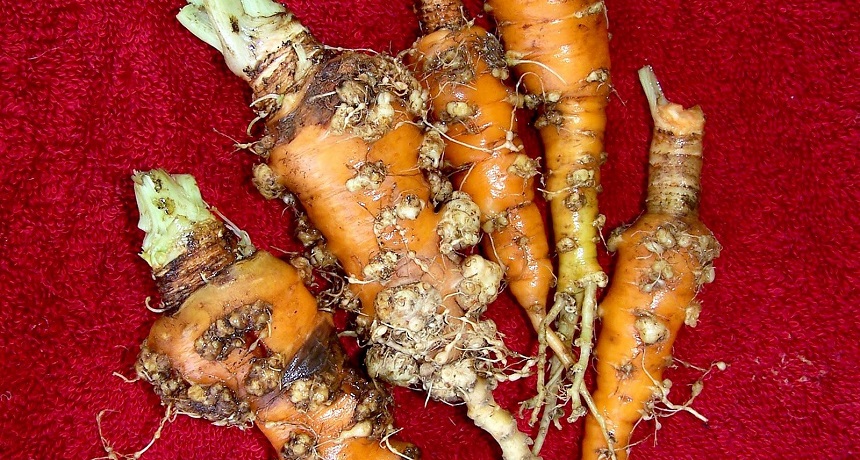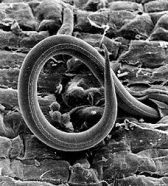Teen helps plants fight off pests
A student's research could help plants target tiny worms that slide into plant roots undetected

These sad looking carrots are covered in galls, lumps caused by tiny worms called nematodes.
Scot Nelson (CC BY-NC-SA 2.0)
WASHINGTON, D.C. – Farming is a risky business. Every year, farmers lose some of their crops to chewing insects, invading fungi or hungry worms. Plants often are helpless to fight back. And if the crops die, it’s a big loss for the farmer and for the people who want healthy, affordable foods. Now, a teen has studied ways to use an invading worm’s own weapons against it, giving crops a chance to defend themselves.
Kalia Firester, 17, is a senior at Hunter College High School in New York City. She presented her research at this year’s Intel Science Talent Search. Run by Society for Science & the Public and sponsored by Intel, the competition brings 40 seniors here to present their research and compete for awards. Kalia’s project won her second place in this year’s “Global Good” category, which honors students whose projects show their passion to make a difference.
Working with a graduate student in a lab at the Volcani Center in Bet Dagan, Israel, Kalia studied the root-knot nematode (Meloidogyne javanica). It happily dines on onions, tomatoes, broccoli, wheat, carrots, oats and more. The nematode is tiny, between 400 and 1,000 micrometers long. That’s length is about equal to the thickness of 10 stacked sheets of paper.

Galls also can harm the plant. Their huge cells can cut off the root’s access to water and nutrients. If too many nematodes move in, a plant will die. And because the worms live in the roots, Kalia says, the plants give farmers few symptoms of infection. By the time the farmers find the galls, it’s often too late to save the plants.
Kalia wanted to know why the plants never seem to fight back against these worms. “It’s not like the pest is subtle,” she says. “[The galls they make] are enormous. There should be plant responses,” she says — defenses “to combat the pests.” She decided to search for some explanation for why there wasn’t.
She focused on one of the nematode’s chemical secretions. Call FAR, it stands for fatty-acid and retinol-binding protein. This protein snaps up fatty acids — long chains of carbon and hydrogen atoms.
These fatty acids feed the nematode. But Kalia and the scientists she worked with discovered that these fatty acids play another role: They signal when a plant is under attack.
They identified the gene for FAR. It holds the instructions the worm cells use to make the protein. This gene resides in the worm’s DNA — long, twisting molecules that instruct a cell about what chemicals to make.
The teen helped to take the gene for FAR and transfer it into a tomato plant. The plant now could make FAR on its own and Kalia could observe exactly what role FAR played inside the plant. Tomato plants making FAR developed bigger nematode galls, she found. These galls also grew faster than normal.
If having the FAR gene made plants develop bigger galls, Kalia and the scientists reasoned that giving the plants the ability to block FAR might slow the growth of those galls.
To find out, Kalia used a technique called RNA interference. It blocks RNA — here, the molecule that helps to translate the information from DNA to make FAR. To do this, Kalia manipulated the genes of the tomato plant. Those tweaked genes created molecules that prevented FAR proteins from being made. Without those proteins around, the fatty acids in the plant remained free.
And it turned out that fatty acids are more than worm food. “They are messenger molecules,” Kalia explains. Ordinarily, they signal to the plant that something is wrong. But when the nematode secretes FAR, that protein soaks up those fatty acids. So the plant never gets the warning. And it sees no need to defend itself against the invading worms.
But when FAR was blocked, the signals got through. More importantly: The plant fought back, leading to smaller galls.
Kalia’s research was included in a paper published in 2013 in a scientific journal.
The teen hopes that someday her research will help create plants that can fight off nematodes. “It’s a way to create genetically modified plants that can resist infection,” she explains. Kalia hopes that knowing more about the worms could help scientists give plants the help they need to fight off pests.
Follow Eureka! Lab on Twitter
Power Words
(for more about Power Words, click here)
DNA (short for deoxyribonucleic acid) A long, double-stranded and spiral-shaped molecule inside most living cells that carries genetic instructions. In all living things, from plants and animals to microbes, these instructions tell cells which molecules to make.
fatty acid Large molecules made of up chains of carbon and hydrogen atoms linked together. Fatty acids are chemical building blocks of fats in foods and the body.
gall (in plants) An abnormal growth, often caused by insects, fungi or other plant pests.
gene (adj. genetic) A segment of DNA that codes, or holds instructions, for producing a protein. Offspring inherit genes from their parents. Genes influence how an organism looks and behaves.
Intel Science Talent Search An annual competition run by Society for Science & the Public and sponsored by Intel Corp. Begun in 1950, this event brings 40 research-oriented high school seniors to Washington, D.C. to showcase their research to the public and to compete for awards.
journal (in science) A publication in which scientists share their research findings with the public. Some journals publish papers from all fields of science, technology, engineering and math, while others are specific to a single subject. The best journals are peer-reviewed: They send out all submitted articles to outside experts to be read and critiqued. The goal, here, is to prevent the publication of mistakes, fraud or sloppy work.
micrometer (sometimes called a micron) One thousandth of a millimeter, or one millionth of a meter. It’s also equivalent to a few one-hundred-thousandths of an inch.
nematode A type of roundworm, usually found in soil, that can also live within other creatures as a parasite. It is very small, with no eyes, ears or nose.
peer review (in science) A process in which scientists in a field carefully read and critique the work of their peers before it is published in a scientific journal. Peer review helps to prevent sloppy science and bad mistakes from being published.
proteins Compounds made from one or more long chains of amino acids. Proteins are an essential part of all living organisms. They form the basis of living cells, muscle and tissues; they also do the work inside of cells. The hemoglobin in blood and the antibodies that attempt to fight infections are among the better known, stand-alone proteins. Medicines frequently work by latching onto proteins.
RNA A molecule that helps “read” the genetic information contained in DNA. A cell’s molecular machinery reads DNA to create RNA, and then reads RNA to create proteins.
RNA interference (or RNAi) A technique used to identify the chemical blueprint of gene, or to block the activity of a targeted gene.
Society for Science and the Public (or SSP) A nonprofit organization created in 1921 and based in Washington, D.C. Since its founding, SSP not only has been promoting public engagement in scientific research but also the public understanding of science. It created and continues to run three renowned science competitions: The Intel Science Talent Search (begun in 1942), the Intel International Science and Engineering Fair (initially launched in 1950) and Broadcom MASTERS (created in 2010). SSP also publishes award-winning journalism: in Science News (launched in 1922) and Science News for Students (created in 2003). Those magazines also host a series of blogs (including Eureka! Lab).